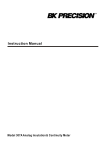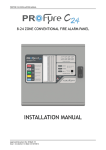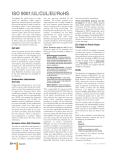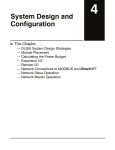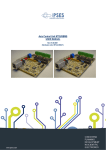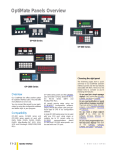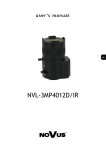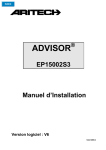Transcript
DL305 Specialty Modules ASCII MODULES FEATURES AND SPECS F3-AB128 F3-AB128-T F3-AB128-R The ASCII/BASIC module interfaces the DirectLOGIC 305 family of programmable controllers with barcode readers, operator interface terminals, instrumentation equipment, computers and other serial devices. The three ports offer a range of communication interfaces and baud rates. Please consult the port descriptions to see which module is best suited for your needs. The ASCII/BASIC modules require the use of a D3-330 or 340 CPU. They are not supported by the D3-350 CPU. Features Applications FACTS Extended BASIC and ABM Commander for Windows software makes program development fast and simple. The software allows full-screen BASIC program editing and the ability to upload/download programs on disk (CD included with module). It also offers: The ASCII/BASIC modules are designed for use with intelligent devices such as: • Options include a built-in 300/1,200/2,400 baud telephone modem or leased-line radio modem. • 128K of non-volatile memory allows multiple program storage and execution; DirectLOGIC™ register expansion, and retentive data storage and retrieval. • 16MHz processor provides fast program execution independent of the DL305 CPU scan. • Floating point math solves complex formulas to eight significant digits. • Programmable from either port 1 or port 2. This provides complete serial port utilization without having to move a cable. • A real-time battery-backed clock/calendar maintains time/date when power outages occur. Programmable time based BASIC interrupts to .005 of a second. • Access of eight bits in and eight bits out per scan. Direct access to blocks of DL305 CPU data when used with the D3-340 CPU (using the built-in serial port). • Three buffered ports permit communication from the module to three or more external devices. • Includes MODBUS master/slave BASIC examples and other application examples. • Bar code readers • Welders • Board level controllers • Serial printers • Intelligent sensors • Almost any device with an RS232C/422/485 port Of course, you may not need these devices for a custom interface. If not, they’re also well-suited for applications requiring complex math such as: floating point math, sine, cosine, tangent, exponential, square roots, powers, etc. Operator interfaces Built-in telephone or radio modem Specifications Module Type ASCII BASIC, I/O Seven maximum, requires 16-pt. I/O slot (may be limited by power budget). 256 character type-ahead input buffer on all three ports. Ports are inde- Modules per CPU Communication pendently programmed by software. seven or eight data bits, one or two stop bits, even, odd, or no parity. XON/XOFF software flow control and RTS/CTS handshake. F3-AB128 128K bytes of battery-backed RAM. 16MHz clock rate. Port 1, RS232C/422/485 selectable, maximum baud rate of 57.6K baud. Ports 2 and 3, RS232C, maximum baud rate of 9600 baud. Port 3 is available by using the RTS/CTS pins on Port 1. If you use these lines on Port 1, then Port 3 is not available. F3-AB128-T 128K bytes of battery-backed RAM. 16MHz clock rate. Port 1, RS232C/422/485 selectable, maximum baud rate of 57.6K baud. Port 3, RS232C, maximum baud rate of 9600 baud. Port 2 features a built-in full-duplex, 300/1200/2400 baud PSK/FSK, asynchronous telephone modem. Automatic dialer with call progress monitoring detects no dial tone, ring and busy. It also automatically answers call. Can be used or remote data acquisition and diagnostics. Allows remote reprogramming of both ASCII BASIC module and DirectLOGIC 330 and 340 CPUs. Port 3 is available by using the RTS/CTS pins on Port 1. If you use these lines on Port 1, then Port 3 is not available. F3-AB128-R 128K bytes of battery-backed RAM, 16 MHz clock rate. Port 1, RS232C, maximum baud rate of 57.6K baud. Port 2 features a built-in 300/600/1200 baud FSK, asynchronous leased-line/data radio modem (no RS-422/485). The modem is Bell 103/113/108, Bell 202, CCITT V.221 and V.23 compatible, with fast response times for direct connection to leased-line networks and radios. Full or half-duplexed operation, 4-wire or 2-wire connection. Transmit and receive 600 ohm transformers provide 1500VDC isolation and common-mode rejection. Adjustable transmit level and receive sensitivity for non-standard interfaces. Port 3 is available by using the RTS/CTS pins on Port 1. If you use these lines on Port 1, then Port 3 is not available. ABM Commander for Windows (Included with Module) Programming/documentation software for FACTS Engineering BASIC module. Key features include: • Runs under Windows 95/98/2000 or Windows NT 3.51 or later. • Command Mode allows the user to program and debug with a "Point and Click" or Command Line Interface. • Uses standard Windows applications for off-line edited (Notepad) and terminal emulation (Hyperterminal) • Text Upload and Download BASIC programs • Binary Upload and Download BASIC programs • Extensive help file contains full user manual information • Includes Modbus master and modbus slave BASIC programs and other application examples Field Termination Nine-pin D-sub connectors. F3-AB128-T also uses RJ12 telephone jack Power Consumption 90mA maximum at 9VDC (supplied by base power supply) 205mA maximum at 9VDC for F3-AB128-T and F3-AB128-R Operating Environment 0°C to 60°C (32°F to 140°F), 5% to 95% humidity (non-condensing) Manufacturer FACTS Engineering 5–30 PLC Products 1 - 80 0 - 633 - 0405
